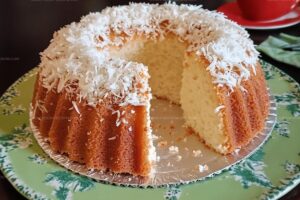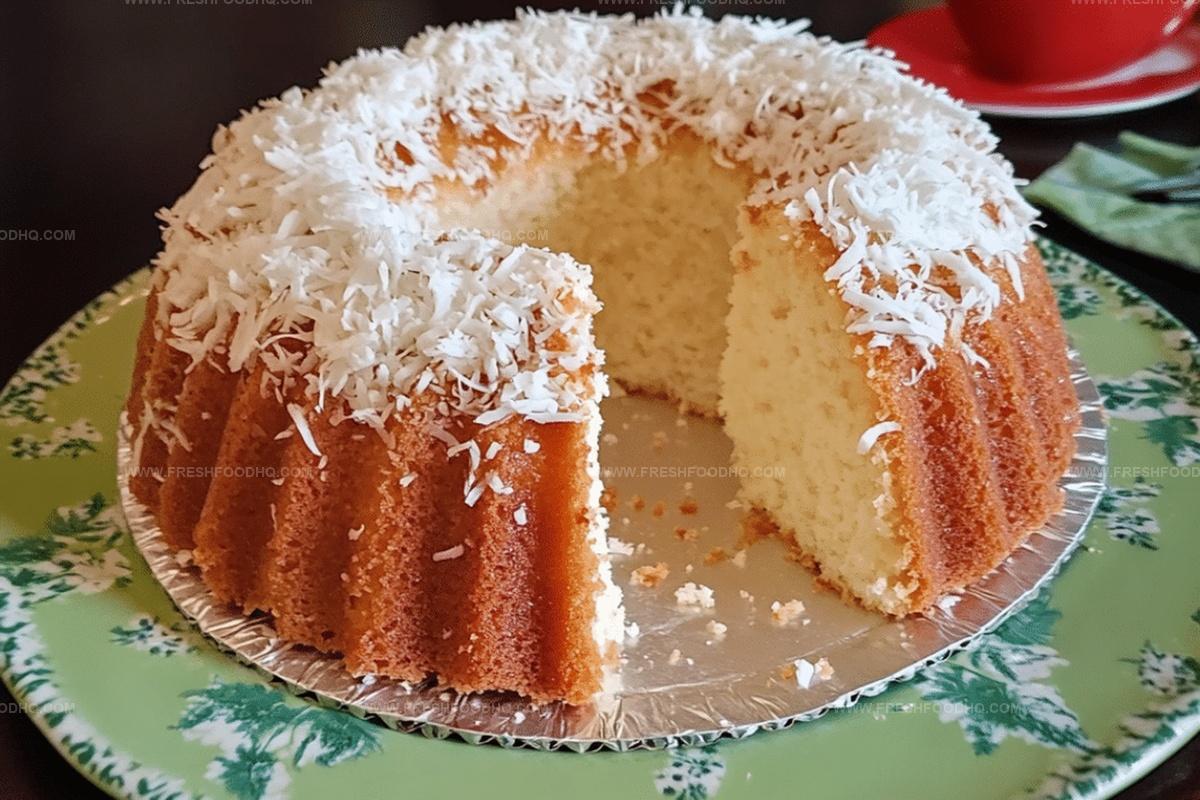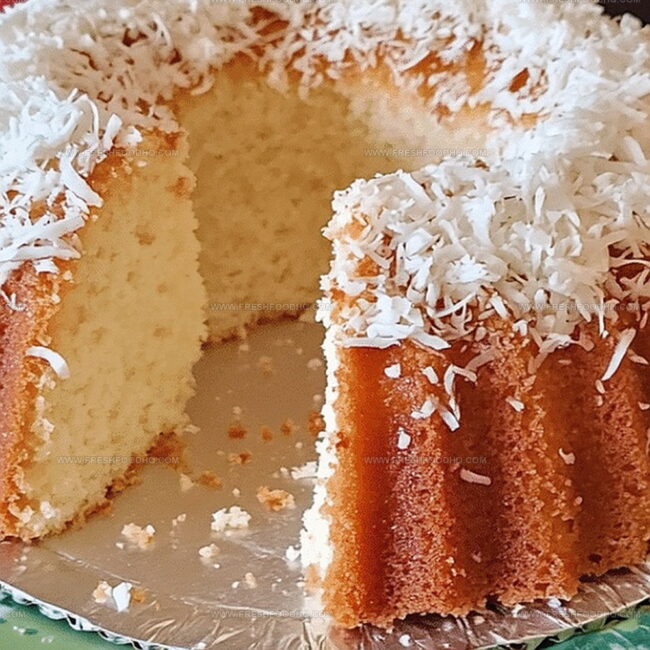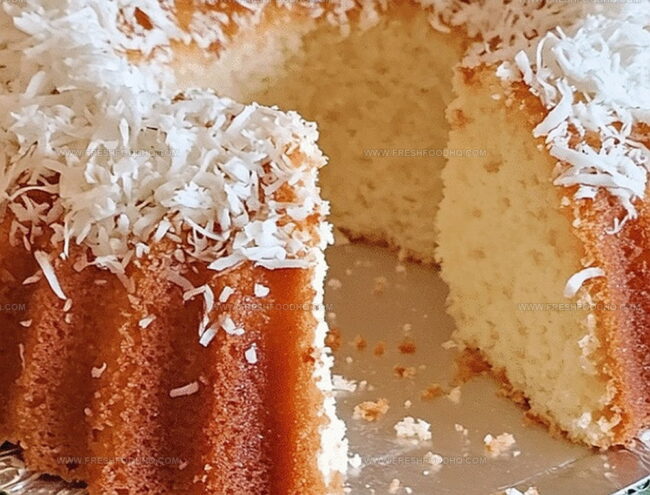Easy Coconut Poundcake Recipe: Golden Sweetness in Every Bite
Baking a delightful coconut poundcake offers a tropical twist on a classic dessert that’ll transport you to sun-drenched shores.
Creamy coconut flavors weave magic through each tender slice.
Memories of lazy afternoons and sweet indulgence dance across your palate with every bite.
Rich, buttery textures mingle with tropical notes that sing of relaxation and comfort.
Dense yet light, this cake promises a moment of pure culinary bliss.
Simple ingredients combine to create something truly extraordinary.
What Makes Coconut Poundcake So Moist and Flavorful
Ingredients for Coconut Poundcake
Main Ingredients:Liquid Ingredients:Dry Ingredients and Extras:How to Bake Coconut Poundcake
Step 1: Warm Up the Oven
Set your oven to a toasty 350°F and lovingly coat a 9×5 inch loaf pan with a generous layer of butter or cooking spray.
Step 2: Create a Creamy Base
In a spacious mixing bowl, whip the butter and sugar together until they transform into a light, airy cloud of deliciousness. Use an electric mixer to achieve that perfect, fluffy texture.
Step 3: Introduce the Eggs
Crack the eggs into the butter mixture one by one, beating thoroughly after each addition. Splash in the vanilla and coconut extracts, stirring until everything is beautifully combined.
Step 4: Blend the Dry Ingredients
In a separate bowl, whisper together:Gradually sprinkle the dry mixture into the wet ingredients, alternating with smooth coconut milk. Mix gently but thoroughly to keep the batter smooth and lump-free.
Step 5: Embrace the Coconut
Fold in the shredded coconut, distributing it evenly throughout the batter. This adds a delightful texture and intense tropical flavor to your cake.
Step 6: Bake to Perfection
Pour the silky batter into the prepared loaf pan. Slide it into the preheated oven and bake for 60-70 minutes. The cake is ready when a toothpick inserted into the center comes out clean and dry.
Step 7: Cool and Serve
Let the poundcake rest and cool completely on a wire rack. This helps it set and makes slicing a breeze. Cut into thick, inviting slices and enjoy the tropical paradise in every bite!
Pro Tips for Moist Coconut Poundcake
Variations to Try With Coconut Poundcake
Pairing Suggestions for Coconut Poundcake
Storage Tips for Coconut Poundcake
FAQs About Coconut Poundcake
Yes, you can use low-fat coconut milk, but the cake might be slightly less rich and moist compared to using full-fat coconut milk.
The mixture should look light, fluffy, and pale in color, with a smooth and creamy texture that increases in volume.
While not mandatory, using both extracts enhances the overall flavor profile, giving the cake a deeper, more complex coconut and vanilla taste.
Absolutely! Chopped toasted almonds or macadamia nuts would complement the coconut flavor and add a nice crunch to the poundcake.
Print
Coconut Poundcake Recipe
- Total Time: 75-85 minutes
- Yield: 12 1x
Description
Sweet coconut poundcake beckons with rich, buttery layers and tropical essence. Moist crumb and golden exterior invite readers to savor this classic dessert that brings Southern comfort directly to their table.
Ingredients
Main Ingredients:
- 3 cups all-purpose flour
- 2 cups granulated sugar
- 1 cup coconut milk
- 1 cup unsalted butter, room temperature
- 4 large eggs
- 1 cup shredded coconut
Extracts and Flavoring:
- 1 teaspoon vanilla extract
- 1 teaspoon coconut extract
Leavening and Seasoning:
- 1 teaspoon baking powder
- 1/2 teaspoon salt
Instructions
- Prepare the oven to 350°F and thoroughly coat a 9×5 inch loaf pan with cooking spray or butter.
- Using an electric mixer, whip butter and sugar together until the mixture becomes airy and pale, approximately 3-4 minutes.
- Incorporate eggs individually, mixing thoroughly after each addition, then gently blend in vanilla and coconut extracts.
- Sift together flour, baking powder, and salt in a separate mixing bowl to ensure even distribution.
- Gradually introduce dry ingredients into the butter mixture, alternating with coconut milk to maintain a smooth, consistent batter.
- Gently fold shredded coconut into the batter, ensuring even distribution without overmixing.
- Transfer batter into the prepared loaf pan, smoothing the top with a spatula for an even surface.
- Bake in the preheated oven for 60-70 minutes, checking doneness by inserting a toothpick into the center – it should emerge clean and dry.
- Remove from oven and let the cake rest in the pan for 10 minutes before transferring to a wire rack to cool completely.
- Once cooled, slice and serve at room temperature.
Notes
- Toast the coconut before folding into the batter to enhance its nutty, rich flavor and add a delightful crunch to the cake.
- Use room temperature ingredients to ensure smooth, even mixing and a perfectly textured pound cake with no lumps.
- For a gluten-free version, swap regular flour with a cup-for-cup gluten-free flour blend, maintaining the cake’s tender crumb and delicious coconut profile.
- Brush the warm cake with a light coconut rum glaze after baking to intensify the tropical essence and keep the cake moist.
- Prep Time: 15 minutes
- Cook Time: 60-70 minutes
- Category: Desserts
- Method: Baking
- Cuisine: American
Nutrition
- Serving Size: 12
- Calories: 434
- Sugar: 28 g
- Sodium: 110 mg
- Fat: 22 g
- Saturated Fat: 18 g
- Unsaturated Fat: 4 g
- Trans Fat: 0.2 g
- Carbohydrates: 54 g
- Fiber: 2 g
- Protein: 5 g
- Cholesterol: 70 mg




Samantha Lee
Recipe Developer & Content Creator
Expertise
Plant-based and vegetarian recipes, Recipe testing and development, Food blogging and digital content creation, Culinary education and workshops
Education
Oregon Culinary Institute (Portland, OR)
Samantha sees cooking like painting, every fresh herb, every juicy tomato, a new splash of color on a canvas.
After graduating from Oregon Culinary Institute, she blended her love of global cuisines and plant-based cooking into recipes that feel fresh, fearless, and full of heart.
Samantha’s kitchen is a place where comfort food gets a modern remix and every meal feels like a little adventure. When she’s not cooking, she’s out exploring farmers’ markets, sketching new recipe ideas, or getting her hands dirty in a community garden.